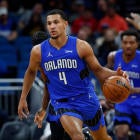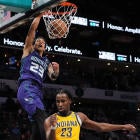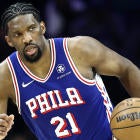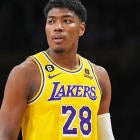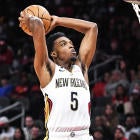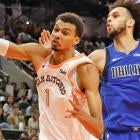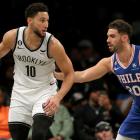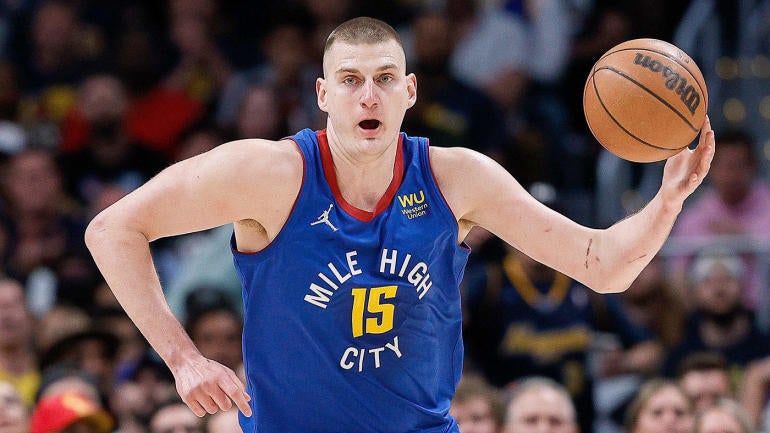
Tiering is one of the most popular ways to prepare for a Fantasy basketball draft. Within each position group, separating players into tiers is an effective means of projecting general value and keeping organized during your draft. If you're in a position where you need to make a quick decision, consulting a set of tiers can help settle the debate between two players who are relatively close in value.
Entering the 2022-23 season, the NBA's talent pool is deeper than ever, so going into your drafts with a plan is more imperative than ever. Early on, drafting the top talents should be the priority, but as the draft progresses, it's important to be cognizant of which positions you're stocking up on and which you'll need to target in the mid-to-late rounds. Tiers can help achieve the roster balance most fantasy managers are hoping to come away with.
Here are our center tiers, which can serve as a general guide for those playing in standard leagues.
Tiers assume eight-category settings. Each player only appears in one set of tiers. Players are assigned to the position at which they're likely to play the most.
Tier 1
Jokic was the top player in fantasy last year and added a second MVP award to his resume. Jamal Murray and Michael Porter will be back this season, so it might be difficult for Jokic to duplicate his 31.9 percent usage rate. Still, Jokic should be the first overall pick in drafts this season and is one of the safest fantasy options, regardless of position.
Tier 2
Last season was the best of Embiid's career, thanks, in large part, to his ability to stay healthy. The center played a career-high 68 games while averaging career highs in points (30.6), assists (4.2) and steals (1.1) and adding 11.7 rebounds and 1.5 blocks in 33.8 minutes. Embiid ranked second in MVP voting and was second-team All-NBA for a second straight season. In fantasy, Embiid ranked third in both total and per-game production. Injury concerns remain, but Embiid's upside ensures that he's worth a first-round pick, especially given that the only center better in fantasy basketball is Nikola Jokic.
Tier 3
Towns again shined last season, averaging 24.6 points, 9.8 rebounds, 3.6 assists and 2.0 three-pointers. The big question fantasy managers will need to consider when deciding where to draft Towns for the coming campaign is how the addition of Rudy Gobert will impact his numbers. Gobert tends to clog up the lanes and dominate the boards, so it wouldn't be surprising for Towns' rebounds and blocks to dip a bit. On the other hand, Towns should have even more opportunities to space the floor and fire away from deep.
Tier 4
Sabonis provides a rare skillset for a player of his size. He's a walking double-double, averaging at least 18.5 points and 12.0 rebounds in each of the last three seasons. Although he doesn't provide much in the way of blocks, he makes up for it with his ability to rack up assists. He averaged a career-high 6.7 dimes during the 2020-21 season, further cementing himself as a top fantasy option. Sabonis has one of the highest floors in fantasy among big men, making him an excellent selection in the second or third round of drafts.
Rudy Gobert
After spending nine years in Utah, the Jazz traded Gobert to the Timberwolves this offseason in a blockbuster deal that netted the rebuilding Jazz a wealth of draft picks. The new situation is interesting for the three-time All-Star, but his role will likely remain unchanged, especially on defense. He'll camp at the rim and swat away opponent shots with ease. Gobert's rebounding could dip slightly playing next to Karl-Anthony Towns, but he will likely still rank near the league leaders. Offensively, he'll remain a pick-and-roll option and an easy lob target for high-efficiency looks at the basket.
Last year, for the fifth consecutive season, Adebayo increased his points per game, shots per game and steals per game. Playing a huge role in Miami's perennial success, Adebayo stands as the lone source of interior grit after P.J. Tucker's migration to Philadelphia. Playing time could hit an all-time high for the 26-year-old. If Miami asks him to anchor the basket more often, an uptick in rebounding and shot blocking is likely.
Robert Williams
Williams broke out in 2021-22. The human pogo stick exploded for 10.0 points, 9.6 rebounds and 2.2 blocks per game last season -- all career highs. With Daniel Theis now in Indiana, Williams could see a slight bump in the 29.6 minutes per contest he played last season. Considering fellow big Al Horford is 36 years old, the C's seem thin at the four and five. There is room for improvement as Williams enters his age 25 season. Hopefully, the shot blocker can avoid the injury issues that plagued him in 2018-19 and 2019-20.
Last season marked the center's first full campaign with the Bulls after he was traded to Chicago during the 2020-21 trade deadline. While he continued to put up strong counting stats -- 17.6 points, 11.0 rebounds, 3.2 assists, 1.0 steals and 1.0 blocks -- his efficiency took a significant and surprising step backward. However, most of that damage was done early in the season. In October, November and December, he shot just 42/35/64 for 15.8 points per game, which increased to 18.7 points per game on 50/29/82 shooting from January onward. Optimistic fantasy managers could assume the start of the year was simply an adjustment period for Vucevic, and his numbers in the final months of the season will be more representative of his future production.
Ayton's tumultuous offseason ended when the Suns elected to match the four-year, $133 million offer by the Pacers to keep the big man in the desert. Ayton's traditional center style of playing almost exclusively around the rim doesn't have quite the same draw as it once did. However, what he does, he does very well. Ayton connected on a career-best 63.4 percent of his shots from the field and averaged a double-double for a fourth consecutive campaign. While the Suns' financial investment should guarantee big minutes for Ayton, he only excels in two categories -- rebounds and field goal percentage.
Tier 5
Allen looks like one of the best young centers in the league and an important building block for the Cavaliers. He averaged a career-high 32 minutes per game last season, putting up averages of 16.1 points, 10.8 rebounds and 1.3 blocks. He also shot an impressive 67.7 percent from the field, while not hurting fantasy managers with his 70.8 percent mark from the free-throw line. Allen might not be in the top-tier of fantasy centers, but he comes with an extremely high floor, making him someone worthy of an early-round selection.
Last season marked Valanciunas' first with the Pelicans after he signed a two-year, $30.1 million extension with the team following a trade from the Grizzlies. Zion Williamson missing the entire season allowed Valanciunas to see plenty of usage. But Valanciunas' numbers may take a slight dip this season while playing next to the high-usage trio of Williamson, CJ McCollum and Brandon Ingram. We also may see Valanciunas shoot more threes to help space the floor for Williamson, who does all of his damage at the rim.
While Turner is slated to be the starting center in Indiana, trade rumors continue to swirl as much as they have for the past couple of years. Turner ended the 2021-22 campaign with a league-leading 2.8 blocks per game. Add to that the fact he shot a career-high 51 percent from the field while connecting on a career-best 1.5 triples, and you have a player who still has a lot to offer. Based on what we know right now, he should be able to replicate those numbers. However, managers will want to keep in mind that his value primarily relies on one category. If his block numbers fall significantly, his overall value will take a hit.
With plenty of potential in Sengun, and the team going nowhere fast, the Rockets dealt Wood to the Mavericks this offseason, which should open up the starting center job for Sengun. A young, exciting core is starting to take shape between Sengun, Jalen Green and Jabari Smith. With Sengun likely to play around 30 minutes per game in his new role, he can provide enough production across the board to be extremely valuable.
Tier 6
After injury-riddled 2019-20 and 2020-21 seasons, Nurkic stayed relatively healthy last year, though he was shut down at the end of the year with the Trail Blazers tanking, so he appeared in just 56 games in the end. He had a solid bounceback season, ranking 73rd in per-game fantasy production. He's a quality option for fantasy managers looking to bolster the center position with a legitimate starter in the later rounds of drafts, but his ceiling is relatively low unless the Blazers' key players are hit by injuries.
Last season marked the third consecutive year Poeltl saw increased minutes, and it marked the best season of his career by a significant margin. This season, he should have room to grow yet again. The Spurs are in one of the best tanking situations in the NBA, with their best player arguably being Keldon Johnson. Poeltl can only handle so much usage as a traditional center without much of a post game, but he's displayed upside as a passer and could handle the ball more frequently than ever before.
Capela was one of the better traditional starting bigs in the NBA last season. However, his workload was slightly reduced as the Hawks tried Onyeka Okongwu out more at the position, while Danilo Gallinari and John Collins also got some small-ball minutes at the position. Even so, Capela averaged a double-double for the fifth straight season and shot over 60 percent (61.3%) for the fourth time during that stretch. Not much is expected to change for Capela this season, though having another skilled passer in the backcourt with Dejounte Murray next to Trae Young should generate more easy buckets around the rim. That said, Atlanta seems interested in examining what it has in Okongwu - drafted No. 6 overall in 2020 - and Collins will presumably catch occasional minutes at center again.
Wendell Carter
Carter compiled the best year of his career in his first full season with the Magic. The No. 7 overall pick from 2018 reached per-game highs nearly across the board. In 29.8 minutes, he averaged 15.0 points, 10.5 rebounds and 2.8 assists, plus consistent three-point shooting (3.5 attempts at a 32.7 percent clip) to his repertoire. This season, not much should change for Carter. He'll remain Orlando's starting center. He may need to share more touches with No. 1 overall pick Paolo Banchero and a healthy Markelle Fultz, but Fultz, in particular, is a good playmaker and could get Carter better looks around the rim.
Tier 7
Robinson has now put up top-100 value for the past four seasons, although his overall ranking in 2021-22 did take a minor hit, as did his playing time. After recently agreeing to a new four-year deal with the Knicks, the front office appears invested in Robinson as their long-term center. Foul trouble remains an issue for Robinson when it comes to logging heavy minutes, which somewhat caps his overall upside. With Isaiah Hartenstein now an accomplished backup, we could see situations where he sees more court time than Robinson, despite coming off the bench. Until we see otherwise, Robinson should be a relatively safe target in the ninth or tenth round, keeping in mind that his value is tied heavily to his high block rate and elite field goal percentage.
Al Horford
After being rested by OKC for the second half of the 2020-21 season, Horford returned to Boston and generated 10.2 points, 7.7 rebounds, 3.4 assists and 1.3 blocks over 29.1 minutes per game. Yes, Robert Williams is the more dynamic big in Boston, but Horford provides the steady day-to-day production down low that the Celtics crave. Understandably, it was reported in July that Horford is expected to face multiple workload restrictions in 2022-23. Look for the veteran to miss the second of most back-to-backs. Plus, while Horford will still start, Boston would love for him to play fewer minutes per game and be fresh for the playoffs.
Tier 8
Zubac became the Clippers' full-time starting center last season, and he put together a career year with Kawhi Leonard out for the entire campaign. In 24.4 minutes per game, Zubac averaged 10.3 points on 62.6 percent shooting, 8.5 rebounds, 1.6 assists and 1.5 combined blocks-plus-steals. Given Zubac's chance of being the Clippers' only center on the roster after training camp, he boasts a sturdy floor for next season. It's unlikely he sees minutes in the high-20s to low-30s consistently, however, as the team projects to often utilize small-ball lineups with Robert Covington, Marcus Morris or Nicolas Batum at center. Ultimately, fantasy managers should expect Zubac to be a back-end center option in most formats, though he's better suited for deep leagues given his minimal upside.
Bamba is coming off his best season, posting career-best marks nearly across the board. Jonathan Isaac missing the whole season opened up time in the frontcourt, and coach Jamahl Mosley was comfortable playing Bamba alongside other bigs like Wendell Carter, Moritz Wagner and Robin Lopez to relative success. In his 25.7 minutes per game, Bamba averaged 10.6 points, 8.1 rebounds, 1.7 blocks and 1.2 assists. The Magic selected forward Paolo Banchero with the No. 1 overall pick over the summer, and Jonathan Isaac will be back in the mix. Both players are practically locks to see 20-plus minutes per game (especially Banchero), and Orlando even has forwards Franz Wagner and Chuma Okeke to also log healthy minutes. That may force Bamba into a true backup center role behind Carter, but he still has per-minute upside.













